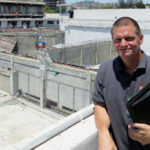Thanks to a generous donation and a dedicated teacher, science students at Palmetto Middle School are about to get a big boost in their learning technology. The students, led by science teacher Kathryn Garciga, are now proud pioneers in the world of virtual reality.
The VR/AR journey began as a pet project for Garciga, who purchased Google cardboard VR goggles for her classes before realizing they weren’t working with her curriculum needs. The use of students’ own phones was also a source of concern for the teacher. After researching, Garciga found many options for personal use, but few for classroom needs. “The several turnkey educational systems available all have benefits and problems,” explains Garciga. “After much looking, I found ClassVR – the winner of the yearly BETT (British Educational Training and Technology) Conference for 2016. It had everything I wanted, as well as, a large price tag for the amount of equipment I needed.”
For Garciga, funds would come in the form of a generous donation from the family of Barbara Gomez, a longtime supporter of science education. Thanks to a $50,000 gift, Garciga was able to take part of the money to purchase a full set of ClassVR to cover each of her six daily Physical Science Honors and Honors Gifted classes. Many are already embracing the technical ability of the technology, be it with training using VR or as educational aids. Developed as the state-of-the-art system by Avantis Education Systems in the UK, and in coordination with Crunchfish, one of the top AR technology firms in Sweden, the system provides eight sealed headsets in a durable charging case. “I have four cases – 32 headsets,” says Garciga. “As the teacher, I am able to control what the students see, manipulate where they look and/or allow them to explore the experience independently.” The set comes equipped with more than 500 “experiences” from which Garciga can build lessons as well as access to lessons from other ClassVR teachers around the world.
Garciga says her 170 seventh and eighth grade students will be “guinea pigs” in the VR/AR realm, but she anticipates using the system in school wide science curriculum in time. “The ability to put students in a virtual environment, rather than showing them pictures in a book or a video is wonderful,” she says. “Understanding concepts like acceleration is hard for students who do not drive. It is calculating movement that speeds up, slows down or changes direction. It’s supremely boring until I put you on a roller coaster… then, suddenly, those same calculations are far more interesting.”
Students are already excited and tested the system with lessons on plant cells and, appropriately, the flu virus. Garciga now hopes to find funds to buy a 360-degree camera, which would allow students to film and create their own lessons and expects to collaborate with other departments to use the technology for everything from history and geography to astronomy lessons. “We are the very forefront of VR/AR education,” says Garciga. “It is going to change the way we teach. VR/AR cannot replace a teacher. Instead they expand my abilities – now I can really offer my students the world.”










 Deering Estate
Deering Estate
 Massage Envy South Miami
Massage Envy South Miami
 Calla Blow Dry
Calla Blow Dry
 My Derma Clinic
My Derma Clinic
 Sushi Maki
Sushi Maki
 Sports Grill
Sports Grill
 The Healthy Kitchen
The Healthy Kitchen
 Golden Rule Seafood
Golden Rule Seafood
 Malanga Cuban Café
Malanga Cuban Café

 Kathleen Ballard
Kathleen Ballard
 Panter, Panter & Sampedro
Panter, Panter & Sampedro
 Vintage Liquors
Vintage Liquors
 The Dog from Ipanema
The Dog from Ipanema
 Rubinstein Family Chiropractic
Rubinstein Family Chiropractic
 Your Pet’s Best
Your Pet’s Best
 Indigo Republic
Indigo Republic




 ATR Luxury Homes
ATR Luxury Homes


 2112 Design Studio
2112 Design Studio
 Hamilton Fox & Company
Hamilton Fox & Company
 Creative Design Services
Creative Design Services
 Best Pest Professionals
Best Pest Professionals
 HD Tree Services
HD Tree Services
 Trinity Air Conditioning Company
Trinity Air Conditioning Company
 Cisca Construction & Development
Cisca Construction & Development
 Mosquito Joe
Mosquito Joe
 Cutler Bay Solar Solutions
Cutler Bay Solar Solutions


 Miami Royal Ballet & Dance
Miami Royal Ballet & Dance
 Christopher Columbus
Christopher Columbus
 Pineview Preschools
Pineview Preschools
 Westminster
Westminster
 Carrollton
Carrollton
 Lil’ Jungle
Lil’ Jungle
 Frost Science Museum
Frost Science Museum
 Palmer Trinity School
Palmer Trinity School
 South Florida Music
South Florida Music
 Pinecrest Orthodontics
Pinecrest Orthodontics
 Dr. Bob Pediatric Dentist
Dr. Bob Pediatric Dentist
 d.pediatrics
d.pediatrics
 South Miami Women’s Health
South Miami Women’s Health

 The Spot Barbershop
The Spot Barbershop
 My Derma Clinic
My Derma Clinic




 Miami Dance Project
Miami Dance Project

 Rubinstein Family Chiropractic
Rubinstein Family Chiropractic
 Indigo Republic
Indigo Republic

 Safes Universe
Safes Universe
 Vintage Liquors
Vintage Liquors
 Evenings Delight
Evenings Delight





 Atchana’s Homegrown Thai
Atchana’s Homegrown Thai
 Baptist Health South Florida
Baptist Health South Florida

 Laser Eye Center of Miami
Laser Eye Center of Miami
 Visiting Angels
Visiting Angels
 OpusCare of South Florida
OpusCare of South Florida

 Your Pet’s Best
Your Pet’s Best





 HD Tree Services
HD Tree Services
 Hamilton Fox & Company
Hamilton Fox & Company


 Creative Design Services
Creative Design Services